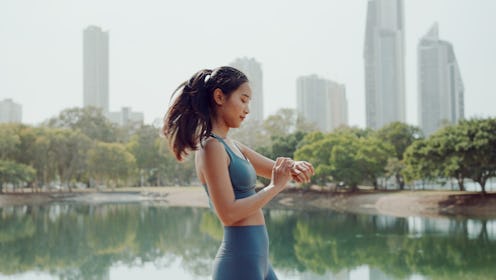Fashion
What To Wear While Working Out To Prevent Bacne

If you're prone to clogged pores and breakouts on your chest, back, or other areas of your body besides your face, you may be more aware of certain things like what the best type of fabric to wear while working out is. And for good reason. Choosing the right workout gear can not only affect how comfortable you are but also how healthy your skin stays. So to find out some tips for how to make sure your workout isn't ruining your skin, I emailed with Dr. Christine Falsetti and Dr. Clarissa Shetler, founders of C2 California Clean, and Dr. Elizabeth Tanzi, founder and director of Capital Laser & Skin Care and Assistant Clinical Professor for the Department of Dermatology at the George Washington University Medical Center.
When selecting your workout clothes, the most important thing to look for, says Dr. Tanzi, is the fit. This, she says, is because "Tight clothing occludes the pores causing irritation, inflammation, and eventual acne." So even if you wear a fabric that wicks sweat from the skin, if it's too tight and affects the skin's ability to breathe, it could be doing more harm than good when it comes to clogged pores and bacne.
However, as long as the fit is not so loose that it impedes your workout or so tight that it causes irritation, the next important factor to look at is what your workout gear is made of. According to Drs. Falsetti and Shetler, fabrics touted as wicking, technical, or performance are generally best for any sweat-inducing exercise (including winter sports), as these are "considered breathable fabrics that draw moisture away from the skin to keep it dry and comfortable." Some such fabrics include polyester, lycra, spandex, bamboo, and wool.
But if you're wondering why it's so important that sweat doesn't stay on your body while exercising (it's supposed to help cool you down after all, right?), Drs. Falsetti and Shetler explain that it has to do with the bacteria that ultimately become laced in your sweat. "When we sweat, we excrete a protein called sialomucin that is like candy for bacteria," they say. So when the bacteria is drawn to your sweat, the best way to keep it from lingering on your skin and affecting your skin health is by "wearing non-absorbing fabrics that pull the sweat to the outside of the fabric to be evaporated." (As opposed to fabrics like cotton that absorb moisture but then stay heavy and wet throughout your workout.)
Regardless of what you end up wearing while working out though, all three doctors warn against lingering in your clothes after exercising, as some sweat and bacteria will inevitably remain trapped against your skin. So to keep your skin healthy, it's best to schedule your sweat sesh when you have time to immediately hop in the shower afterwards.
And to really make sure your skin stays healthy and blemish-free following a workout, Drs. Falsetti and Shetler add that it is important to stay hydrated both inside and out. They explain that by drinking plenty of water and regularly moisturizing your skin, you can better keep your skin's protective barrier intact, thereby protecting your body from bacteria, pollution, and toxic agents.
C2 California Clean The Rejuvenator Dry Oil Emulsion, $88, Amazon
Because working up a sweat can be good for your skin— as long as you make the right fashion choices.
Images: Getty Images (3); Courtesy of brand